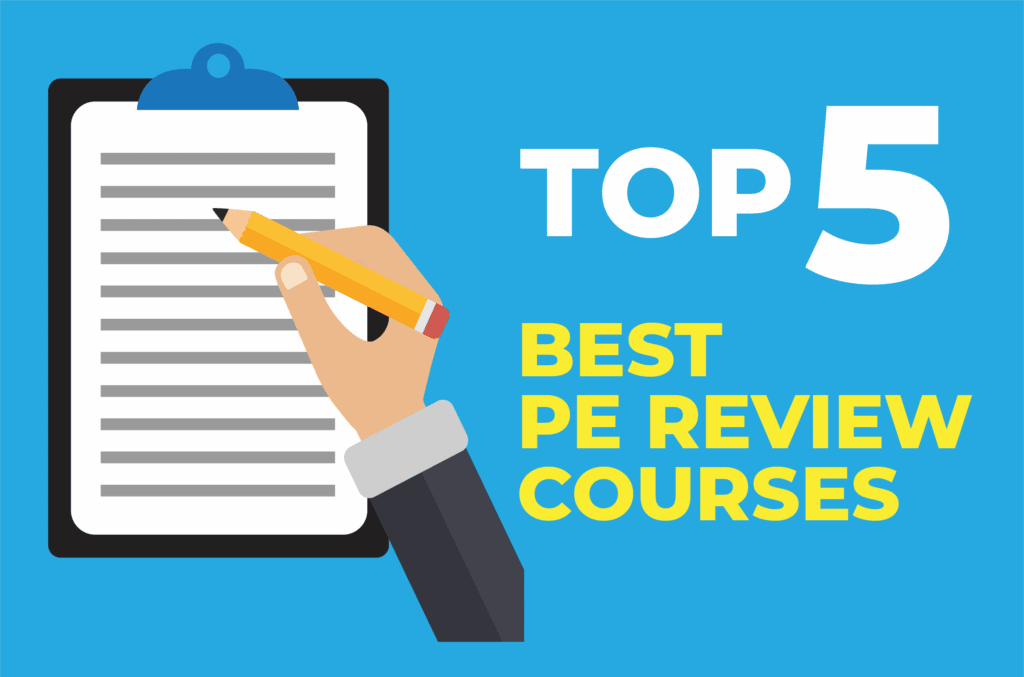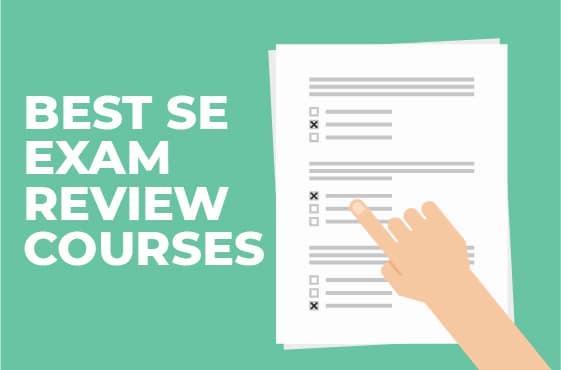If you’ve had your engineering degree for a few years and passed the FE exam, you probably keep hearing that getting a Professional Engineer (PE) license will give you a nice bump in your paycheck and better job opportunities.
Taking the Principles and Practice of Engineering (PE) exam is next on your list, but you’ve heard it’s hard and you’re not sure where to start.
We’re here to help you out! Check out these simple tips to help you register, study and pass the PE exam.

Why Take The PE Exam?
Many companies don’t require the PE, and all that studying sounds like a drag, so you might be wondering:
Why should I even bother with this test?
- Better pay!
According to the results of the 2017 ASCE Salary Survey, the median pre-tax income for civil engineers in 2016 was $101,000. Those who had a B.A or B.S. had a net income of $93,000, while those with a PE license made significantly more: $108,000. These salaries vary by engineering discipline, but you get the idea.
- Stand out from the crowd.
Having the PE means you have at last four years of experience beyond your degree and a broad understanding of the engineering principles in your specific field.
When you apply for your next job, no one is going to wonder if you know what you are doing. You will undeniably be a qualified and experienced applicant.
- The ability to Sign and Seal Plans and Drawings
Only licensed engineers can submit plans and drawings. With a PE, you can also be in charge of work in the private sector.
Plus, the seal is pretty cool!

So What Exactly is a Professional Engineer (PE)?
A professional engineer has several additional credentials that demonstrate professional competence to employers, clients and peers.
The National Society of Professional Engineers explains that in order to become a licensed PE, you must:
- Earn a four-year degree in engineering from an accredited engineering program
- Pass the Fundamentals of Engineering (FE) exam
- Complete four years of progressive engineering experience under a PE, and
- Pass the Principles and Practice of Engineering (PE) exam
So what are you waiting for? Check out how to register for the PE Exam below!

Registering for the PE Exam
You should register online at the NCEES website. Most PE exams are offered in April and October, although a few exams are offered only once a year (check here to see which exams are offered only in April or October).
Choose your state, then select “PE” as your test before entering your discipline. Exam registration fees vary by state and foreign location, and should be paid either to NCEES or your state licensing board, depending on your state’s requirements.
Based on your specific exam, you’ll take either a pencil and paper or a computer-based test. Paper and pencil tests are slowly being converted into computer-based tests, so make sure to check which format you’ll be taking based on your discipline.
If you need to reschedule your exam, follow the instructions on the NCEES website to do so.
PE Exam Cost
The PE Exam fee varies by state (or foreign location) and may be paid to NCEES directly or to your state licensing board. Typically, the exam costs between $350-$375, plus any additional fees your state board requires.
Pass Rates and Scoring
The PE is a challenging exam. As you can see from the most recent PE exam pass rates, many students don’t pass the exam the first time around.
Unfortunately, it gets worse: pass rates for repeat takers are often even lower! You will need a great plan, determination, and excellent study resources in order to succeed.
How is the PE Exam Scored?
Exam results are based on your total number of correct answers. There is no penalty for wrong answers, so be sure to answer every question on the test. The score is scaled to adjust for any differences in difficulty across the different exam forms. The scaled score represents your ability level and is compared to the minimum ability level for that exam.
Although it changes slightly from one session to the next, you basically need a grade of at least 75% to pass.
Step 1: Create a PE Study Schedule

This challenging set of exams has a relatively low pass rate and requires a rigorous plan for review.
Experts recommend at least 3 months of study before you take the exam! Giving yourself plenty of time to go over your practice exam, study guide, or reference manual of choice is essential.
Finding time in your busy schedule to accommodate this much studying isn’t impossible, but signing up for a test preparation course might be your best bet to provide the structure and motivation to stay on top of your review.
The best way to increase your odds of passing is to create an exam study schedule and stick to it. Your detailed study guide should outline all test topics and the amount of time you will dedicate to each topic on the exam.
Step 2: Review for the PE Exam
Practice the Questions!
Lectures and video reviews are fine and all, but make sure you spend a good chunk of time actually solving problems and answering multiple-choice questions.
Engineering forums are full of rueful test takers who wish they had spent more time practicing exam-like practice questions. With 80 questions on the test, you have just 6 minutes per question. Don’t waste your time studying questions that are much harder or unlike those likely to appear on the exam.
Manage Your Time
You’ve got a life, you’ve got a job, maybe you even have a young family, so finding enough time to study for three months or more is going to be challenging.
The good news: enrolling in a prep course can save you time!
The benefits of live classes are:
- They provide you with the right kind of exam-like study questions
- They show you how to solve them quickly and correctly
- They focus your study sessions by sticking to only what’s important to know
- They help you get your notes and references organized for test day
Check out some of the best PE review courses here.

Step 3: Taking the PE Exam
Each PE exam lasts 8 hours and is split into a morning and an afternoon session. You get 4 hours to answer 40 multiple-choice questions during each session.
You are allowed to bring an unlimited number of printed reference materials to the exam. References, including written notes, must be bound; no loose leaf paper is allowed. Check the NCEES website for specific rules regarding books, calculators, cell phones, computers, and security procedures, as these sometimes change.
Wait, Did You Say Open Book?
That’s right – the PE exam is an open book test. That sounds great until you struggle to decide which resources and how many you should bring into the room. Stories of suitcases full of books and notes aren’t unusual, but do you really need all that?
One of the biggest advantages of taking a review course is knowing how to compile a reference manual full of the most useful and relevant sources that you’ll need on exam day.
Past test takers often cite the amazing resource binders and notes they received and used during a course as a key reason for passing the PE exam. You’ll want to tab your most frequently used pages to make sure you can find references and equations as fast as possible.

What’s Tested On the PE Exam?
To a certain extent, this depends on your own discipline (civil, chemical, electrical etc.). But most people take a breadth and depth test or an all depth exam. For example, civil engineers typically take the structural breadth and depth exam, while electrical engineers often take the Power depth exam.
Breadth and Depth
The breadth and depth exam has two parts: the morning breadth section that covers a broader range of topics, and the afternoon depth test which is more specific. Civil and mechanical engineers are most likely to take this type of test.
The breadth test typically includes more general questions from geotechnical, structural, water resources, environmental, and transportation disciplines.
Most people choose an afternoon depth exam that is related to their work and area of expertise.
Depth Only
The depth exam is, not surprisingly, much more specific, with questions that go into much more specialized detail. All other PE exams besides civil or mechanical are in this category.
But What Exactly Should I Study?
The NCEES website lists the topics and roughly how many questions for each will appear on the various PE exams in its section of exam-specific information here. You can download the PDF files and print them out.
Of course, if you enroll in a PE review course, you’ll have an even better idea of what to focus on because someone has already done the work for you! Pro-tip: don’t try to learn everything. Focus only on what is most likely to show up on your particular PE exam.
What to Expect After Your PE Exam
So, what happens after you’ve scheduled, prepared for, and taken your PE exam? You wait for your results!
Getting Your PE Test Results
PE Exam results are graded pass/fail and are released 8-10 weeks after the paper and pencil exam (or 7-10 days after a computer-based exam).
You’ll receive your results via email notification from NCEES with instructions on how to view them in your account or through your state licensing board. If you fail, you’ll have to go back to the start of this guide and schedule a retake.
But if you succeed, then congratulations: you’re a newly minted PE!
COMPARE THE BEST PE REVIEW COURSES
Bryce Welker is a regular contributor to Forbes, Inc.com, YEC, and Business Insider. After graduating from San Diego State University, he went on to earn his Certified Public Accountant license and created CrushTheCPAexam.com to share his knowledge from reviewing hundreds of accounting courses while helping thousands of other accountants become CPAs. Bryce was named one of Accounting Today’s “Accountants To Watch” among other accolades. As Seen On Forbes



